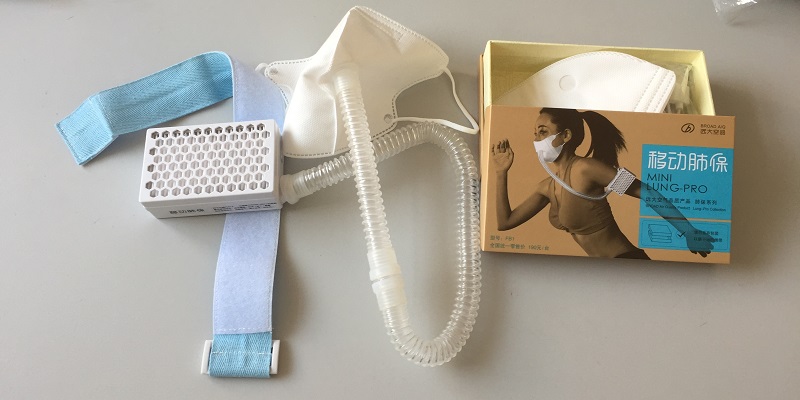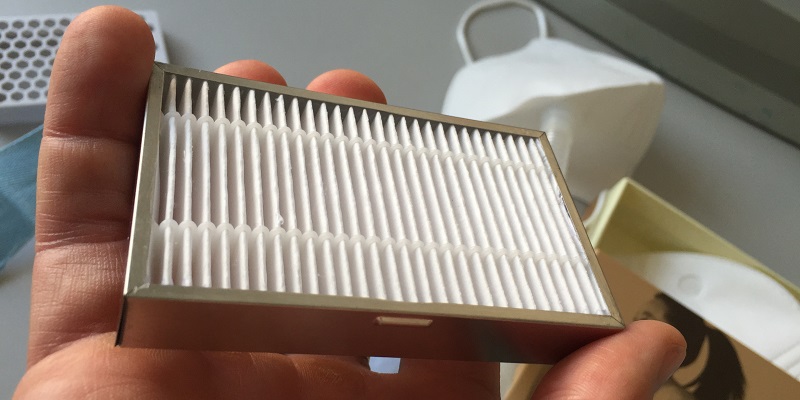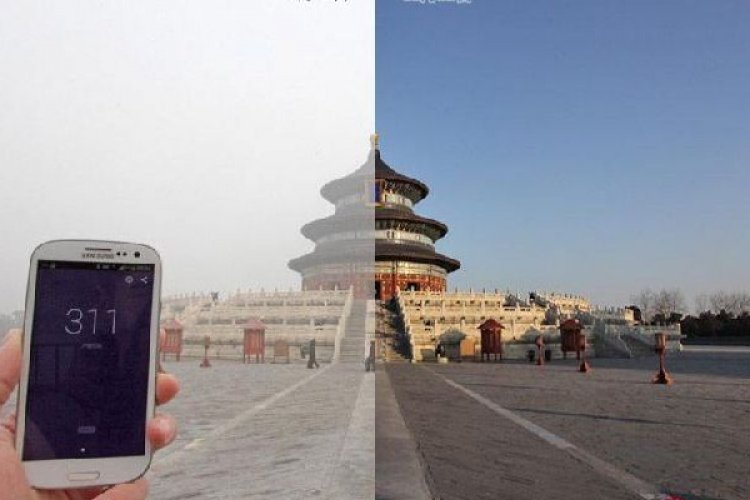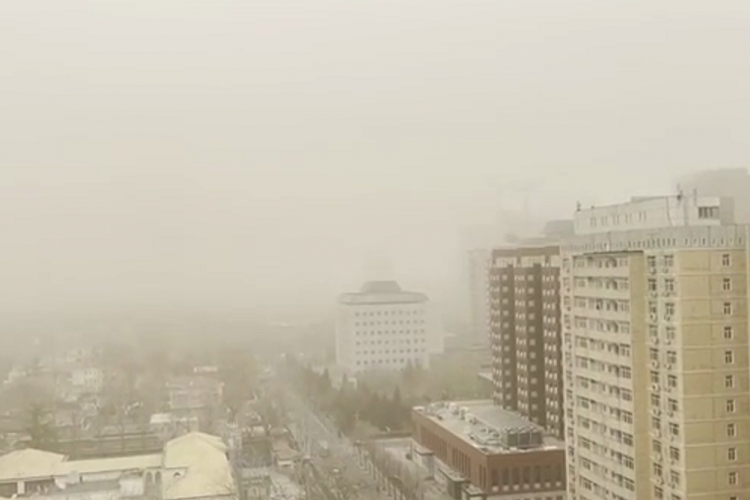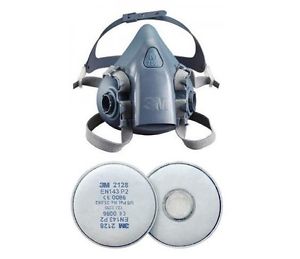This New Air Mask Really Blows (Filtered Air into Your Lungs)
Breathing masks are a necessity for Beijingers that prefer to avoid a gruesome pollution-induced death at an early age.
However, even the most robust of face coverings are only as good as their fit on your face. If a tight seal cannot be achieved around the contours of your features such as the bridge of your nose, pollutants will merely be drawn into the mask as you breathe.
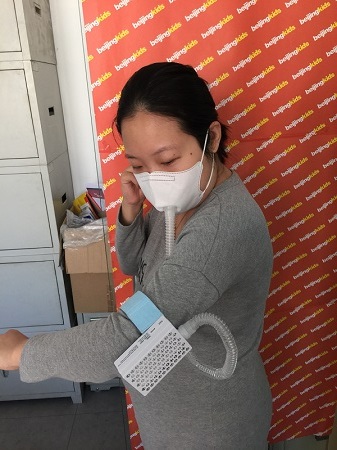
Those issues are addressed with a new smog-busting product that pumps HEPA-filtered air into your mask so that a fresh supply is delivered directly where it counts: right where you draw your breath. The positive air pressure sent to the mask reduces the chances that you'll be inhaling a lungful of particulate matter.
Dubbed the Mini Lung-Pro, this simple gadget consists of a mask attached to a plastic hose, which feeds into a mini air purifier that can be strapped to the wearer’s arm. A cute little HEPA filter about the size of a deck of cards is contained within, which allegedly is good for 200 to 800 hours of use.

Smoggy air is drawn through the device’s filters, which cleanse and then blow it via a fan into the wearer’s mask. The result: particulate matter-reduced air.
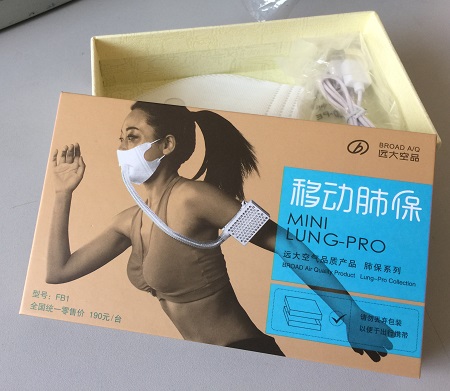
The device has low, middle and high settings that can be utilized at rest, during exercise or anywhere in between. Its battery lasts for 12 hours on the low setting, and can be charged easily with the supplied cable.
The mask that comes with the Mini Lung-Pro is a standard, papery face covering, but the hose can easily be dislodged and fixed (with a little DIY ingenuity, directions included) onto the mask of your choice.
The filter has a slightly noticeable hum, but even at the high setting it is not distracting. The purifier can easily be popped open, allowing users to remove its filter for easy cleaning.
We did an informal test on the filtration ability in the office today, and found that it worked surprisingly well, reducing particulate matter to an almost imperceptible level.
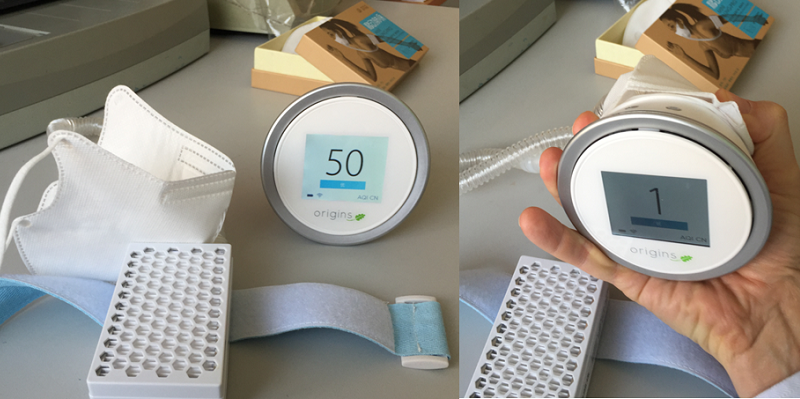
And the process took less than 20 seconds, as you can see in the video below:
The Mini Lung-Pro of course is by no means flawless. For one, it's not too comfy for winter wear, as the stream of air that is pushed into the filter can feel uncomfortably cool as it is blown directly onto the wearer’s face. The RMB 190 price tag puts in may also give customers pause as well, as does the fact that you'll look even more like a space alien than you normally do wearing a mask.
But considering the ease of use and the degree of quality boasted by both the device itself and it effectiveness in filtering the air, the benefits far outweigh the flaws. This is a gadget that offers comfortable, clean breathing at a time when air quality couldn’t be of more concern for Beijingers. So we advise you to strap it on, switch it on, and quit holding your breath for a miracle answer to our city’s pollution problem.
The set itself can be purchased for RMB 190 on Tmall here and a set of 6 replacement mini HEPA filters will set you back RMB 114 here (interfaces are in Chinese only). They are also available in select locations of the Guomei Electronics store (full list in Chinese here), including their shop in the basement of the Solana Mall.
All in all its not a bad little investment – and at RMB 19 for a replacement filter, I'd be inclined to ignore astronomical hourly usage figures and replace the filter every other month (which if you wore it for 2.5 hours daily, would amount to about 150 hours of usage).
Images: Michael Wester
Related stories :
Comments
New comments are displayed first.Comments
![]() admin
Submitted by Guest on Sat, 01/09/2016 - 05:47 Permalink
admin
Submitted by Guest on Sat, 01/09/2016 - 05:47 Permalink
Re: This New Air Mask Really Blows (Filtered Air into Your...
Here's my full review on the Mini LungPro:
![]() admin
Submitted by Guest on Thu, 12/31/2015 - 12:50 Permalink
admin
Submitted by Guest on Thu, 12/31/2015 - 12:50 Permalink
Re: This New Air Mask Really Blows (Filtered Air into Your...
Seems pretty impractical in my opinion and reminds me of those gimmicky mini-masks fitted with menthol to trick the person into thinking the air is somehow fresher. I'd say go for a proven piece of equipment used in occupational settings for decades, like a 3M 7502 half-face respirator fitted with P100 filters. They are on Chinese Amazon and JD.
How's the breathability on the 100s? I've only tried the 95s (not the 99s or 100s)
I anticipate the air resistance would be higher on those, no?
![]() admin
Submitted by Guest on Sun, 12/27/2015 - 03:07 Permalink
admin
Submitted by Guest on Sun, 12/27/2015 - 03:07 Permalink
Re: This New Air Mask Really Blows (Filtered Air into Your...
Here is Dr St Cyr's test of the device on video
![]() admin
Submitted by Guest on Fri, 12/25/2015 - 14:23 Permalink
admin
Submitted by Guest on Fri, 12/25/2015 - 14:23 Permalink
Re: This New Air Mask Really Blows (Filtered Air into Your...
Excellent idea! I just sent an inquiry to them
![]() rstcyrmd
Submitted by Guest on Fri, 12/25/2015 - 14:19 Permalink
rstcyrmd
Submitted by Guest on Fri, 12/25/2015 - 14:19 Permalink
Re: This New Air Mask Really Blows (Filtered Air into Your...
OK here's a proposal for the Beijinger -- or anyone out there. You want a blockbuster article which will get traction for years? You rent a TSI Portacount machine and you do the gold-standard fit tests on any mask you want. The fit test is the only test that really matters -- test results on real faces doing a series of tests for 2 minutes. (I did my own testing a couple years ago thanks to the 3M team http://www.myhealthbeijing.com/china-public-health/the-best-air-purifiers-under-1000-rmb-my-test-results/ ) Test it on a dozen faces and publish the results; even let the public try it. You do an article on kid's masks -- testing every available child size mask on actual kid's faces -- and I guarantee that hundreds of thousands of thankful parents will read it; such testing has never been done and even I would love to see that data. So ask your Beijinger bosses to cough up a small amount of $$, order it from this USA company and they'll ship to China for rental: from Pine Environmental. The rates are: 174 USD/day, 473 USD/week, or 1100 USD/month.
![]() admin
Submitted by Guest on Fri, 12/25/2015 - 13:59 Permalink
admin
Submitted by Guest on Fri, 12/25/2015 - 13:59 Permalink
Re: This New Air Mask Really Blows (Filtered Air into Your...
Another scary thing is automotive exhaust. For a long time I have been puzzling over what mask would protect against vehicle exhaust, which no matter how you slice it does in fact contribute to the air pollution problem, Tragically, I just found my answer via 3M:
"What respirator should I use to protect against vehicle exhaust?
![]() admin
Submitted by Guest on Fri, 12/25/2015 - 13:52 Permalink
admin
Submitted by Guest on Fri, 12/25/2015 - 13:52 Permalink
Re: This New Air Mask Really Blows (Filtered Air into Your...
The other thing that scares me is this:
Presuming a HEPA filter traps pollutants, is there a point at which the filter itself becomes so saturated with toxins that running your machine will actually make the air *worse*? The smaller the filter surface area, the more likely it is the filter would be saturated.
![]() admin
Submitted by Guest on Fri, 12/25/2015 - 13:48 Permalink
admin
Submitted by Guest on Fri, 12/25/2015 - 13:48 Permalink
Re: This New Air Mask Really Blows (Filtered Air into Your...
Actually I am trying to dream up a way of testing masks. The difficulty is that I need some sort of soft latex head with anatomically-correct breathing holes, and the closest I can find is a rather embarassing (and very expensive) full-body sex toy ... given fit is so crucial, any ideas of how to test? I wonder how 3M masks are tested?
![]() rstcyrmd
Submitted by Guest on Fri, 12/25/2015 - 11:21 Permalink
rstcyrmd
Submitted by Guest on Fri, 12/25/2015 - 11:21 Permalink
Re: This New Air Mask Really Blows (Filtered Air into Your...
Yes, I also ordered one of these a few days ago and am very interested to see if it would work. It'd be really interesting to attach it to a 3M mask and see if it's better. But again, for now, you still haven't proven at all that it's worth the cost. And honestly I don't know why you'd feel satisfied that this "delivers significantly cleaner air than what you'd breathe without a mask" because again you have no idea if the fan strength is even powerful enough to overcome normal air leakage. You have to do a fit test for that. So no, you really shouldn't be satisfied based on this one poorly done test and I don't think you should be allowing your readers to make purchasing decisions on such poor testing.
At least you could re-run the tests using the correct screens?
![]() admin
Submitted by Guest on Fri, 12/25/2015 - 11:00 Permalink
admin
Submitted by Guest on Fri, 12/25/2015 - 11:00 Permalink
Re: This New Air Mask Really Blows (Filtered Air into Your...
But again even the Laser Egg test isn't the best test because it's not testing on the face. Your result means nothing if the fan speed is so small or if the mask fits so poorly that dirty air gets inside. So again you haven't proven at all in any meaningful or accurate way that this new mask is good. That's why fit testing is the most important. (I hope in the next month to repeat my testing of masks, and also test all the new positive pressure masks like the Freeair and this one above).
Of course we have not made laboratory-style testing, but I'm satisfied that the motorized fan and filter delivers significantly cleaner air than what you'd breathe without a mask.
The joy of this device is it includes DIY instructions on how to affix it to the mask of your choice, with little effort, so the fit of the supplied mask is not that important.
I am getting one and putting it on one of my 3M masks.
The one issue I'd have is: maybe the mask's filtered air does not provide any significant advantage over a regular mask -- so maybe not worth it.
![]() rstcyrmd
Submitted by Guest on Fri, 12/25/2015 - 10:15 Permalink
rstcyrmd
Submitted by Guest on Fri, 12/25/2015 - 10:15 Permalink
Re: This New Air Mask Really Blows (Filtered Air into Your...
Whoa, hold on there a second, you haven't proven at all that this mask is good. First of all, your test is flawed -- you should he using the third or fourth screen on the Laser Egg (the concentration in ug/m3 or the particle count). You can't use AQI in comparisons ever because it's not a linear calculation. And the Chinese vs AQI screens would show different results anyway. Secondly, a drop from 50 to 4 is actually really bad. It should go to 1. Any over the counter disposable 3M N95 mask would have a better number than 4. But again we don't really know because your test is flawed.
Here's an example video I made during the airpocalypse of how to properly use the Laser Egg to test powered masks: This is the Freeair mask, which lowered PM2.5 from >40,000 particles to zero particles.
But again even the Laser Egg test isn't the best test because it's not testing on the face. Your result means nothing if the fan speed is so small or if the mask fits so poorly that dirty air gets inside. So again you haven't proven at all in any meaningful or accurate way that this new mask is good. That's why fit testing is the most important. (I hope in the next month to repeat my testing of masks, and also test all the new positive pressure masks like the Freeair and this one above).
Validate your mobile phone number to post comments.

